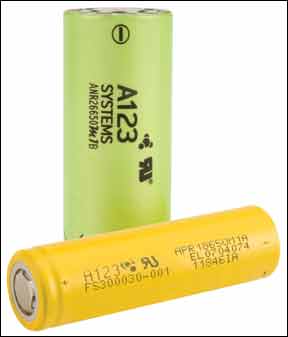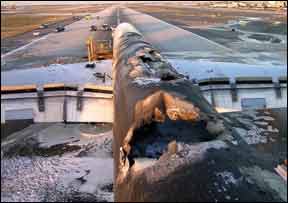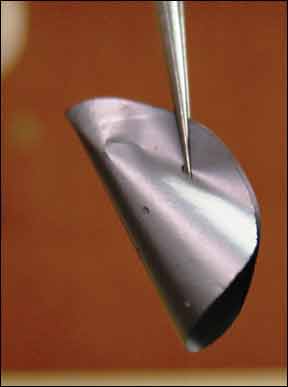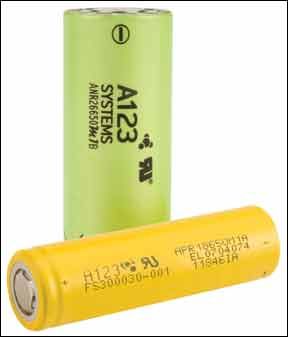For the great wide world of transportation, the lithium-ion battery is the shining city on the hill, that pivotal bit of technology that will have us whizzing around in silent cars banishing the evils of carbon dioxide. For aviation, lithium-ion is both an enigma and an opportunity.

To understand both, you need only to grasp three numbers: 50, 150 and 1700. The opportunity part resides in the first two numbers—a lead-acid battery’s energy density is about 50 Wh/kg, a third or less than that of the typical lithium-ion’s 150 Wh/kg. Now for the enigma. The 1700 is the Wh/kg energy content of gasoline, adjusted for the typical internal combustion engine’s 20 percent efficiency. The very best lithium-ion batteries can do at the moment is 400 Wh/kg and these don’t exist commercially yet. That means the practical electric airplane may be on the horizon, but it’s not around the corner.
Lithium batteries ought to be a slam dunk for one application, though: starting and main aircraft batteries. “They’re twice the capacity and half the weight,” says Skip Koss of Concorde Battery, a leading GA supplier. The only thing is, he says, they’ve been known to erupt in violent flames from time to time, thus Concorde isn’t satisfied that the technology is yet worth the risk.
Electrics Cars are Driving
The market for lithium-ion batteries in aviation is bifurcated and although not strong yet, it’s certain to go that way. What’s driving development, including capacity improvement, new chemistries and safety, is the emerging electric vehicle market. But two other segments are promising, too: grid batteries that are used for smoothing out and backing up commercial electrical grids and IT/data applications. Aviation will be a fraction of this, but it’s still seen as a growth market.
For aviation, primary batteries for electric airplanes have thus far been based largely—although not exclusively—on the lithium-cobalt-oxide technology that’s popular for notebook computers. Panasonic and Sony are big players in these markets and these batteries find their way into developmental airplanes through companies that buy the individual 3.6-volt cells and custom package them for specified voltages and amp-hour requirements. The battery pack in the PC-Aero Electra One Solar electric airplane we saw in Germany last spring uses a 60-volt system that PC-Aero’s Calin Gologan told us is a compromise between safety and efficiency.

Electric airplanes have been—and remain—hamstrung by battery energy density considerations. Even though the best mass-market lithium-ion technology is now capable of nearly 200 Wh/kg, twice that density would make them more marketable. Panasonic, whose batteries Gologan uses in the Solar One, promised higher watt density batteries, but hasn’t delivered.
“The technology exists. I think they don’t bring it for economical reasons. They don’t want to start to the production lines,” Gologan says. Meanwhile, PC-Aero has equipped its soon-to-be intro airplane with solar cells that can extend flight time by 50 percent. Gologan believes for the fly-for-fun market that electric airplanes will represent initially, 90 minutes to a couple of hours of slow-speed endurance is sufficient and he believes currently available batteries can do that. Obviously, if electric airplanes are to become serious contenders in, first, the training market and later personal transportation, better batteries are a must. Everyone in this field we spoke to tells us they’re sure these are coming, but no one knows when or what their capacity will be. In Slovenia, innovative Pipistrel has been offering an electric version of its Taurus G2 motorglider since 2007. Total sales so far? One, although more are expected to ship this year. Current battery technology allows two climbs to 4000 feet, followed by 3.5 hours of charging, says Pipistrel’s Tine Tomazic, who takes claims of battery capacity doubling within five years with a pound of salt.
“Since 2007, when we flew the prototype G2, the energy density went from 163 (Wh/kg) to 185 for the same power required,” he said. That’s not much progress in five years, although Pipistrel says it’s confident enough in better batteries to plan an all-electric version of its new Panthera and also an electric Alpha trainer. Meanwhile, Pipistrel is also developing a hybrid. (See sidebar opposite page.)
Where Are the Batteries?
With the industry stuck at the 200 Wh/kg barrier, if not practically a lot less, where and when is this new battery capacity supposed to appear? These turn out be difficult questions to pin down. We spoke with Bill Mitchell, VP of commercial solutions at A123, a startup company that has become a leader in EV batteries but who also sees potential in aviation.
A123 is championing a lithium-iron-nanophosphate technology that it claims has good energy density and is more stable than the cobalt-oxide chemistries that currently dominant the market. The holy grail of lithium efficiency is to move lithium ions through the electrolytes and electrodes more efficiently and A123’s nano-size particles do that, says Mitchell. Further, because they vent when thermally stressed, they’re less volatile than oxide batteries, whose electrolytes of lithium salts dissolved in flammable organic solvents are highly susceptible to intense fires. (A123’s claims notwithstanding, its cells were used in a Citation that torched in a battery fire last year. More on that later.) Mitchell told us the working nameplate energy density of today’s cells is 130 to 150 Wh/kg and he sees that doubling over the next few years. “Few” is fuzzy, but if it’s three to five years, that’s unlikely to shift the electric airplane market into high gear.
Pipistrel’s Tomazic said doubling energy density would open up some possibilities, such as two more takeoffs in the G2 motorglider before recharge or more “get home” energy from a longer flight. He reckons most operators would opt for the takeoffs and use the G2 as a glider trainer.
What about longer term? ”Ten years from now? The crystal ball gets a lot more cloudy,” says A123’s Mitchell. “There are a lot of chemistries out there that have promise to increase energy density, but they’re still at the early stage.”

One of those was revealed at last spring’s CAFE Electric Aircraft Symposium in Santa Rosa, California, where battery researcher Cary Hayner from Northwestern University discussed what has become know as “10X” technology, implying a ten-fold increase in energy density.
“The 10X issue is a bit tricky,” Hayner told us via e-mail. “Although we increased the capacity ten-fold in the anode electrode—you can also say equivalently that we increased the anode energy density (Wh/kg) by roughly ten-fold as well, maybe slightly less like eight-fold—consumers will not be able to see the ten-fold increase in energy in electronics on the market,” he explained.
That’s because the cathode hasn’t been upgraded yet, although even with current technology, Hayner believes the new anodes could improve energy density by 30 or 40 percent, and the new anode may be commercially viable with current cathodes over the short term.
“To fully realize the ten-fold increase in energy density, we would need to couple our anode technology with an oxygen cathode electrode, which may not be feasible for many more years—this is what is called ‘Li-air’ technology,” Hayner said. The Northwestern team improved energy density by inserting “in-plane” defects in their graphene anode material, allowing more efficient movement of lithium ions.
A Citation Burns
That lithium batteries bring promise with peril was illustrated by Cessna’s recent experience. In a well-suppressed event in Wichita last fall, a Citation CJ4 equipped with a lithium-ion battery with A123 cells caught fire and burned, according to an FAA-issued AD on the incident. We’re not sure if the airplane was a hull loss, but it sustained significant damage. Neither Cessna nor A123 replied to our requests for additional detail.
Whatever the case, Cessna immediately issued a recall service bulletin to remove lithium-ion batteries for about 50 CJ4s and on October 6, 2011, an emergency AD appeared requiring the same. The batteries were replaced with lead-acid or NiCad, by owner choice. Cessna did say it is committed to lithium-ion technology and hasn’t given up trying.
Significantly, the Citations had battery installations approved by the FAA, which has expressed serious reservations about lithium ion for aircraft main batteries and has developed stringent certification requirements. According to the FAA, since 1991, there have been 53 aviation-related incidents—fires and minor explosions—involving consumer-grade lithium-ion batteries. These have occurred on cargo aircraft, passenger aircraft and in terminals. (To be fair, lead-acid, NiMh and NiCads have also been involved in more incidents.) It’s possible, if not likely, that two major hull losses have occurred because of lithium battery fires, both in UPS aircraft. One occurred in Philadelphia in 2006, the other in Dubai in 2010. The latter, a 747, was carrying 81,000 lithium-ion batteries, but in neither case could investigators say with certainty that the batteries ignited the fires. Nonetheless, the risk is viewed as so serious that the FAA restricted passenger airplanes from carrying non-rechargeable lithium batteries as cargo in 2004 and new regulations will go into effect next year requiring more stringent labeling and packaging. Without these, a study by ICAO predicted an aircraft loss every two years due to battery fires. All of this tends to taps the brakes on lithium batteries for GA.

What’s the Problem?
The principle source of volatility in lithium-ion batteries is their highly flammable lithium salt and organic solvent electrolytes. Lithium metal itself is highly volatile, but only small coin or camera cells have metallic lithium. That’s a good thing, for these have been implicated in some lively small-scale explosions.
Although lithium chemistries vary in their sensitivity to overcharging, a single overcharged cell in a pack can initiate thermal runaway. “When one goes, it tends to propagate to the other cells and you have a real problem,” says Concorde’s lithium-ion expert, Dave Vutetakis. A single cell is difficult to extinguish, but with several popping off, losing the airplane is likely and this may have been what happened in Cessna’s Citation fire.
Lithium-iron nanophosphate—A123’s specialty—is considered one of the most stable chemistries, but it still has a hull fire on its record.
Several layers of redundant protection are thus needed, starting with electronic battery management systems that monitor the cell temperature and keep charge rates balanced. BMSs also keep the battery from discharging entirely, in which case it’s ruined.
“I think it would be foolhardy to market a lithium-ion battery without good electronics,” Vutetakis said. A robust enclosure is also a good idea, although that obviates some of the weight savings. Vutetakis says the electronics can’t protect against one risk: internal cell shorts. This can and has happened. “That’s why you had the big battery recalls for laptops,” he told us. Cell shorting is a risk for all-electric airplanes, but the charging risk is much less because this occurs only on the ground. In either case, the risk may be statistically low, but the consequences are severe.
If it sounds like lithium-ion will never make it into GA starting batteries, it already has. A company called Aerovoltz is marketing lithium-iron- phosphate batteries through Aircraft Spruce for experimental applications. The company’s Steve Johnson told us it has thousands of A123-cell Li-ion in the motorsports market with no safety issues. The battery cases are hardened against flame propagation. It’s also developing BMS options. Mid-Continent Instruments and Avionics recently announced that it will begin marketing A123’s cells, albeit not finished batteries. Mid-Continent is already marketing a line of certified Li-ion backup battery units.
As for certified aircraft, Concorde says lithium-ion will come eventually, but it’ll be awhile. Skip Koss told us he doesn’t yet see much market for batteries that are definitely lighter than the best lead-acid models and more energy dense, but that will also cost four to five times as much. And Concorde says it won’t move forward until it’s comfortable that the Li-ion risk is lower than it is now. We agree that taking this one slow is the way to go.


